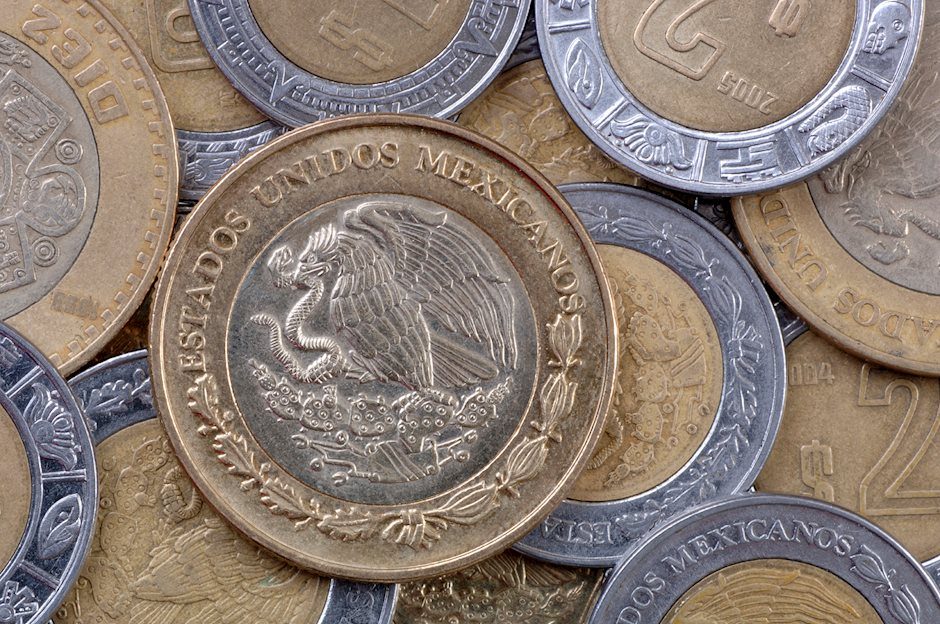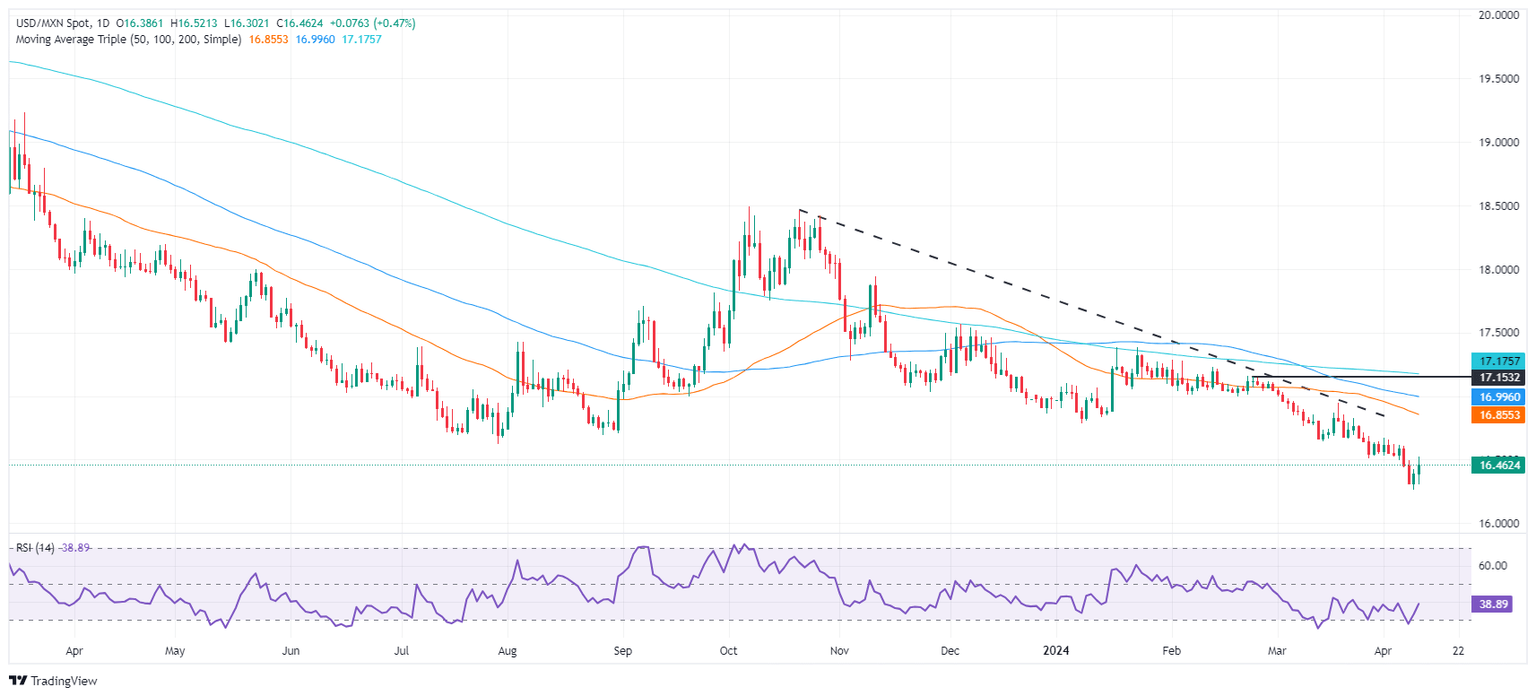Mexican Peso drops as US high inflation might dent Fed rate cuts

Most recent article: Mexican Peso stands firm against US Dollar despite mixed production data
- Mexican Peso weakens as higher-than-anticipated US inflation figures might deter Fed from easing policy
- Rising US Treasury yields and a strengthening US Dollar contribute to Peso depreciation.
- USD/MXN's ascent underscores heightened economic vigilance, with traders eyeing potential moves towards the 17.00 mark.
The Mexican Peso depreciated against the US Dollar following the release of an inflation report in the United States (US) on Wednesday. Prices in the largest economy in the world were higher than expected, prompting traders to price in two interest rate cuts instead of three in 2024 from the Federal Reserve (Fed). The USD/MXN trades at 16.50, a new two-day high, and gains 0.78%.
US data was the driver of price action in the USD/MXN pair. The US Bureau of Labor Statistics (BLS) revealed that March’s Consumer Price Index (CPI) was unchanged in three of the four inflation readings, while the headline CPI exceeded estimates and February’s number.
After the data, US Treasury yields rose, the Greenback climbed, and US equities tumbled. The Chicago Board of Trade’s (CBOT) fed funds rate futures have priced in two rate cuts throughout the full year, with December’s contract projecting the Fed will ease policy to 4.95%.
The USD/MXN jumped from around 16.30 and reached a daily high of 16.52 before stabilizing at current exchange rate levels. Therefore, the Mexican Peso remains pressured, and a daily close above 16.50 could pave the way for a correction to 17.00.
Daily digest market movers: Mexican Peso tumbles after US inflation report
- Mexico’s Consumer Price Index (CPI) was lower than estimated as the disinflation process continued. In the same tone, core CPI decelerated on a yearly and monthly basis, justifying the Bank of Mexico's (Banxico) decision to lower rates on March 21. However, not everything was good news for the central bank, as the yearly CPI exceeded estimates.
- Mexico’s CPI rose 0.29% MoM, according to the National Statistics Agency (INEGI). This was lower than the expected 0.36% increase and higher than the 0.09% rise noted in February. Core figures rose by 0.44%, which was lower than the 0.51% that economists had forecast and below the 0.49% increase in February.
- The US Consumer Price Index (CPI) increased 0.4% MoM and 3.5% YoY, exceeding estimates, with annual inflation also punching above the previous month’s number. The underlying CPI, which excludes volatile items like food and energy, was above projections but remained unchanged compared to February’s data at 0.4% MoM and 3.8% YOY.
- US Treasury bond yields skyrocketed, with the short end of the curve, namely the 2-year T-note, climbing 20 basis points.
- The US Dollar Index (DXY) is soaring more than 1%, standing at 105.27, at new year-to-date (YTD) highs.
- Traders are eyeing the release of the Minutes of the latest Fed meeting in March.
Technical analysis: Mexican Peso loses momentum as USD/MXN surges toward 16.50
After diving to a new nine-year low near 16.25, the USD/MXN recovered some ground as the pair aimed above 16.40 and approached the psychological 16.50 area. Once that level is cleared, further upside is seen at last year’s 16.62 mark, followed by the 50-day Simple Moving Average (SMA) at 16.85 and the 100-day SMA at 16.99.
Failure at 16.50 and the USD/MXN could tumble to October’s 2015 low of 16.32 before retesting the year-to-date (YTD) low of 16.25.
Mexican Peso FAQs
The Mexican Peso (MXN) is the most traded currency among its Latin American peers. Its value is broadly determined by the performance of the Mexican economy, the country’s central bank’s policy, the amount of foreign investment in the country and even the levels of remittances sent by Mexicans who live abroad, particularly in the United States. Geopolitical trends can also move MXN: for example, the process of nearshoring – or the decision by some firms to relocate manufacturing capacity and supply chains closer to their home countries – is also seen as a catalyst for the Mexican currency as the country is considered a key manufacturing hub in the American continent. Another catalyst for MXN is Oil prices as Mexico is a key exporter of the commodity.
The main objective of Mexico’s central bank, also known as Banxico, is to maintain inflation at low and stable levels (at or close to its target of 3%, the midpoint in a tolerance band of between 2% and 4%). To this end, the bank sets an appropriate level of interest rates. When inflation is too high, Banxico will attempt to tame it by raising interest rates, making it more expensive for households and businesses to borrow money, thus cooling demand and the overall economy. Higher interest rates are generally positive for the Mexican Peso (MXN) as they lead to higher yields, making the country a more attractive place for investors. On the contrary, lower interest rates tend to weaken MXN.
Macroeconomic data releases are key to assess the state of the economy and can have an impact on the Mexican Peso (MXN) valuation. A strong Mexican economy, based on high economic growth, low unemployment and high confidence is good for MXN. Not only does it attract more foreign investment but it may encourage the Bank of Mexico (Banxico) to increase interest rates, particularly if this strength comes together with elevated inflation. However, if economic data is weak, MXN is likely to depreciate.
As an emerging-market currency, the Mexican Peso (MXN) tends to strive during risk-on periods, or when investors perceive that broader market risks are low and thus are eager to engage with investments that carry a higher risk. Conversely, MXN tends to weaken at times of market turbulence or economic uncertainty as investors tend to sell higher-risk assets and flee to the more-stable safe havens.
Author

Christian Borjon Valencia
FXStreet
Christian Borjon began his career as a retail trader in 2010, mainly focused on technical analysis and strategies around it. He started as a swing trader, as he used to work in another industry unrelated to the financial markets.


















